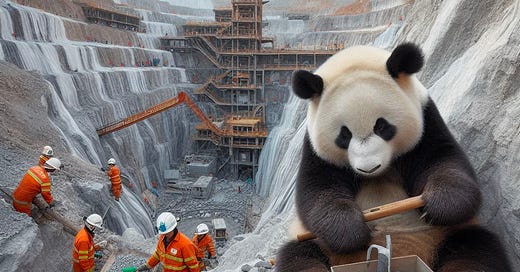Chinese Lithium pt.1: The big boys
Ganfeng Lithium (GNENF US, 1772 HK, 002460 CH) and Tianqi (9696 HK, 002466 CH, TQLSF US)
China has emerged as the heavyweight champion in the global lithium arena, but the real stars of the show are its twin titans: Tianqi and Ganfeng. These two juggernauts didn’t just stumble into greatness—they built empires through a mix of bold global acquisitions, relentless domestic expansion, and savvy positioning. Tianqi snagged a 51% stake in Australia’s legendary Greenbushes mine and a $4.1 billion slice of Chile’s SQM, securing bragging rights to some of the world’s richest lithium deposits (this will keep coming up a lot, but its important!). Meanwhile, Ganfeng went all-in on integration, locking down assets from Argentina to Mali while building a recycling and battery powerhouse in its Jiangxi heartland. Together, they’ve turned China into the lithium world’s powerbroker, outmanoeuvring competitors with sheer scale and strategic foresight.
For those who don’t want to read the whole piece, all 7k words thereof, a concise but opinionated summary is provided at the very end in the Panda Perspective section (you see what I did there).
There will be a part 2 on brine early next week and a more conceptual piece on arriving at price targets for these things with a long term in mind. Sufficed to say if one has a positive view of the energy transition, one cant help but be optimistic on Lithium, but we’ll be attempting to quantify this optimism (or lack thereof) in a subsequent paper. The focus of this one is on the companies themselves, their assets and current financial predicament, in absolute terms and in the context of one another.
A housekeeping point: Christmas is upon us. Give a gift of knowledge to your nearest and dearest (and don’t forger yourself!) Gift subscriptions are now available!
**Important Reminder: Nothing in this Substack is Investment Advice. This information is provided for informational purposes only and does not constitute financial, investment, or other advice. Any examples used are for illustrative purposes only and do not reflect actual recommendations. Please consult a licensed financial advisor or conduct your own research before making any investment decisions. The authors, publishers, and affiliates of this content do not guarantee the accuracy, completeness, or suitability of the information and are not responsible for any losses, damages, or actions taken based on this information. Past performance is not indicative of future results.**
With that out of the way, here comes the longest note i’ve done to date!
China’s lithium industry is a vital and complex sector, characterized by its extensive vertical integration and dominated by a few influential players. Here’s a streamlined overview of its structure, ownership, and market dynamics:
Structure of China’s Lithium Industry
Upstream: Resource Extraction and Refining
Resource Ownership: Although China holds less than 7% of the world’s lithium reserves, its companies have secured substantial resources globally through strategic investments. Key examples include Tianqi Lithium’s 51% stake in Australia’s Greenbushes mine, one of the world’s richest lithium deposits, and a 24% stake in Chile’s SQM.
Refining Capacity: China processes around 80% of the world’s lithium chemicals, thanks to significant investments in technology and infrastructure, enabling efficient conversion of raw lithium into battery-grade materials.
Midstream: Battery Component Manufacturing
Cathodes and Anodes: Chinese manufacturers dominate global production, supplying 78% of cathodes and 85% of anodes—critical components for lithium-ion batteries.
Downstream: Battery Manufacturing
Battery Production: China accounts for about 75% of global lithium-ion battery manufacturing capacity, led by companies like:
Key Market Dynamics
• Vertical Integration: Companies like CATL, BYD, and others control the supply chain from resource extraction to battery assembly, ensuring cost efficiency, quality, and a steady supply of critical materials.
• Government Support: Subsidies for electric vehicles (EVs) and investments in battery technology have bolstered domestic demand and positioned China as a global leader in the EV market.
Keep reading with a 7-day free trial
Subscribe to Panda Perspectives to keep reading this post and get 7 days of free access to the full post archives.




